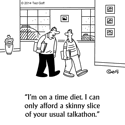Influential business quotes
"You have to be from somewhere," Terrell Holland, GTE, 1984.
My boss at my first job out of college, Terrell was urging a group of new hires, me included, to develop deep skills in some part of the business before trying to branch out to other disciplines. And despite not having done any engineering work or software development for fifteen years, I still find that I approach problems with an engineer's mindset. That's where I'm from.
"Time kills deals," Gordon Adams, EDS, 1994.
I've talked about this before. And I've read criticism of this saying. What Gordon meant was, assuming a deal is worth doing for you and the customer--you can't wait for the deal to come to you. You have to go get it. And I still believe that.
"Ha-ha-ha-ha," Bruce Leonard, EDS, 1996.
Bruce ran our division at EDS and I went to him for some career advice. I was considering going back for a PhD, but wanted to talk about senior management as a possible pathway. I had told him that it seemed to be that there was a huge gap between my capabilities and what was needed to be a senior manager. That executives were somehow different in a quantum way from us midlevel folks. And he laughed.
"When I first started my own practice, I learned this: I was not in the law business; I was in the sales business," Don McFadden, 2006.
Don is my father-in-law. I've heard people say this about consulting: "I love it all except the selling part." Then you are in the wrong business, my friend.
"What I learned from Lenny Bruce was: You don't need the entire audience.... If you're too needy of that entire audience, you won't find your own style. [When I saw Lenny Bruce, he] had only a third of the audience with him. And he didn't mind that at all," comedian David Steinberg on Fresh Air, 2007.
I'm not a standup comedian, but this affected me. It's easy working in business to try to steer to the middle of the road--to try to make everyone happy. But it doesn't work, and worse it limits the value you have. To be all you can be, you have to say what you think, and accept the consequences that some people (maybe most people) won't agree.
sales, consulting, legal, leadership, entrepreneurship












